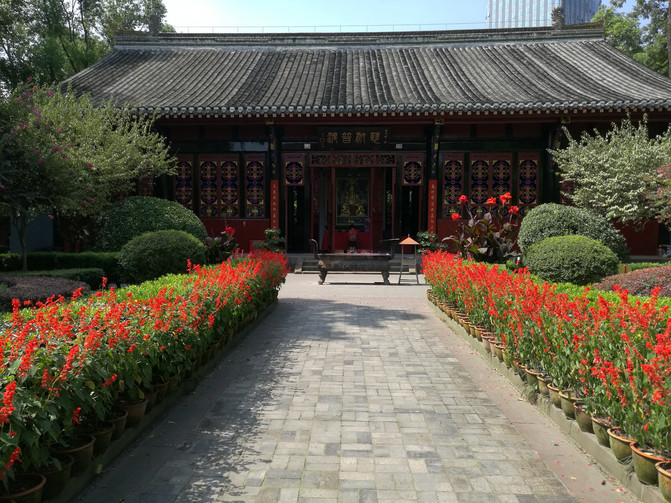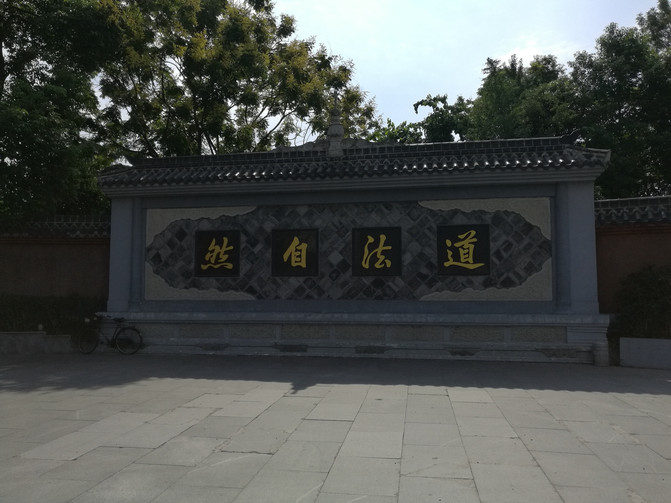Journey to the Land of Abundance (4)
September 7, 2017
sunny day. The itinerary for this day is Qingyang Palace, Du Fu Cottage and Wide Alley. It is actually a leisure style. Because I climbed the mountain two days ago (Mount Emei) and the next two days (Mount Qingcheng), I had to go climbing the mountain (Mount Qingcheng), so I arranged a two-day relaxing tour in the middle.
After breakfast, the sun was already in full swing and it was hot on my body. Exit the hotel and enter the cultural park next to it. Across the park is Qingyang Palace.
Qingyang Palace was built in the Zhou Dynasty and was formerly known as Qingyang Si. By the Ming Dynasty, the temples built in the Tang Dynasty were destroyed by military disasters. Most of the existing buildings were successively rebuilt in the sixth to tenth years of the Kangxi reign of the Qing Dynasty (1667 - 1671 AD). They cover an area of about 120,000 square meters and are one of the famous Taoist palaces in the country.

The main hall of Qingyang Palace is Sanqing Hall, also known as the Promise Hall. It was built in the Tang Dynasty and rebuilt in the eighth year of Kangxi of the Qing Dynasty (AD 1669).
The Sanqing Hall is dedicated to the highest and most respected gods of Taoism, namely, the Yuqing Yuanshi Celestial Venerable, the Shangqing Lingbao Celestial Venerable, and the Taiqing Moral Celestial Venerable, also known as the Taishang Laojun and the Taishang Daozu. There are also twelve golden immortals sculpted on both sides of the hall, namely: Guangchengzi, Chijingzi, Huanglong Immortal, Juliu Sun, Taiyi Immortal, Dandeng Immortal, Manjusri Guangfa Immortal, Puxian Immortal, Cihang Immortal, Yuding Immortal, Daoxing Immortal, Qingxu Moral Immortal.

Doumu Hall is just behind the Sanqing Hall. It was built in the Ming Dynasty. It is the only remaining Ming-style building in Qingyang Palace, with an all-wood structure. In the hall, there is a statue of Yuanjun of the Connate Da Fan with four heads and eight arms. On the left, there is a statue of the Void Supreme Earth Mother Ci Zun (Houtu Emperor Di), and on the right, there is a statue of the Queen Mother of the West. On both sides are enshrined the statues of the Big Dipper, the Six Stars of Nandou and the Eternal Star King of the Antarctic.

Since I am not familiar with Taoism, I can only take a rough look at it.










After leaving Qingyang Palace and going to Du Fu Cottage, it was not far from the map, so I decided to walk and at the same time I could see the street scene.
The scorching sun was shining, but fortunately, the streets in Chengdu were shaded by trees, and it didn't take long to reach Du Fu Cottage.





Du Fu Cottage is the former residence of Du Fu, a great Chinese poet in the Tang Dynasty, whom we are familiar with when he lived in Chengdu. In order to avoid the "Anshi Rebellion," Du Fu took his family and his family from Longyou (now southern Gansu Province) to Sichuan and then came to Chengdu. With the help of friends, we built a thatched hut along the picturesque Huanhua River in the western suburbs of Chengdu. Du Fu lived here for nearly four years and wrote more than 240 poems.
Du Fu's Cottage has been destroyed many times. Wei Zhuang, a poet in the late Tang Dynasty, found the ruins of the thatched house and rebuilt it to preserve it. It was repaired and expanded in the Song, Yuan, Ming, and Qing dynasties.
I once visited Du Fu Cottage in the early 1980s. In my memory, it was not as big as it is now. Some buildings did not exist before. For example, the "Ten Thousand Buddha Pagoda" was rebuilt on the original site in 2005 and has become another landmark building of Du Fu Cottage.

When the foundation of the Wanfo Tower was rebuilt, 24 original Wanfo Tower pillar stones were discovered. At the same time, a number of incomplete building components, animal-shaped decorative parts, round nails and thousands of pieces of objects belonging to the four treasures of daily life and literature were unearthed. Most of these unearthed objects have the style of the Qing Dynasty, and a small number of them belong to the Ming Dynasty and have high cultural relics value.
The excavated pillars of the original Wanfo Tower are left in place and covered with glass for everyone to visit.


▲ (Mobile phone shooting)
Some of the unearthed cultural relics are displayed in the Wanfo Building, most of which are fragments and relics.






▲ (Mobile phone shooting)
Another example is the "Du Fu Thousand Poetry Stele", which was built with a large amount of effort. Du Fu left more than 1400 poems in his life, many of which are well known by everyone.




According to reports, Du Fu's "Thousand Poetry Stele" project is divided into two areas: Du Fu Cottage and Huanhuaxi Park. Among them, the Du Fu Cottage area mainly displays Du Fu's poems written by famous artists from past dynasties, including Du Fu's Poetry Calligraphy Stele Corridor,"Spring Night Happy Rain Garden" and Du Fu's Poetry Excerpts; the Huanhuaxi Park area mainly displays Du Fu's poems written by modern cultural celebrities, mainly including projects and supporting projects such as Poetry Saint Square, Du Fu's poetic landscape of life, Du Fu's famous poems garden, Du Shi Gorge (tentatively named) and the main monument.
We just happened to catch the appearance of the Du Fu Cottage area in the first phase of the project. It is said that the Huanhuaxi Park area in the second phase of the project is in full swing.


After reading the Thousand Poetry Stele, I rushed to the thatched cottage. The thatched hut was restored and rebuilt in 1997 based on the description of Du Fu's poems and the pattern of the Ming Dynasty. It reproduces the pastoral style of the poet's former residence and creates a strong poetic atmosphere.
Du Fu lived here for nearly four years and wrote more than 240 poems. The Cottage covers an area of nearly 300 acres. The building is simple and elegant, and the gardens are quiet and beautiful.





After visiting the Du Fu Cottage Scenic Area for nearly 2 hours, I feel that there are still more tourists and it takes a long time to take some photos.



After leaving Du Fu Cottage, he took a taxi to Kuanzhai Alley.
The wide and narrow alleys are composed of wide alleys, narrow alleys, and well alleys arranged in parallel. They are all antique courtyards made of indigo bricks and tiles. This is also a relatively large-scale ancient street of the Qing Dynasty left over from Chengdu.
It is reported that in the fifty-seventh year of Kangxi (1718), after putting down the Jungar Rebellion, more than a thousand soldiers were selected to garrison Chengdu and build Shaocheng. Today's wide and narrow alleys are the legacy of Shaocheng. Kuanzhai Alley has more than 70 courtyards and more than 300 rooms.
Now the old city wall, Jinshui River, etc. have disappeared. What is displayed in front of us are renovated old buildings and small alleys with a strong commercial atmosphere.











It was already past noon when we arrived at Kuanzhai Alley, so we found a restaurant for lunch and rested. Start shopping and shopping after about 15:00.
Previous Article:October 2021-Self-driving tour around Chengdu
Next Article:Eat and play and travel to Sichuan
